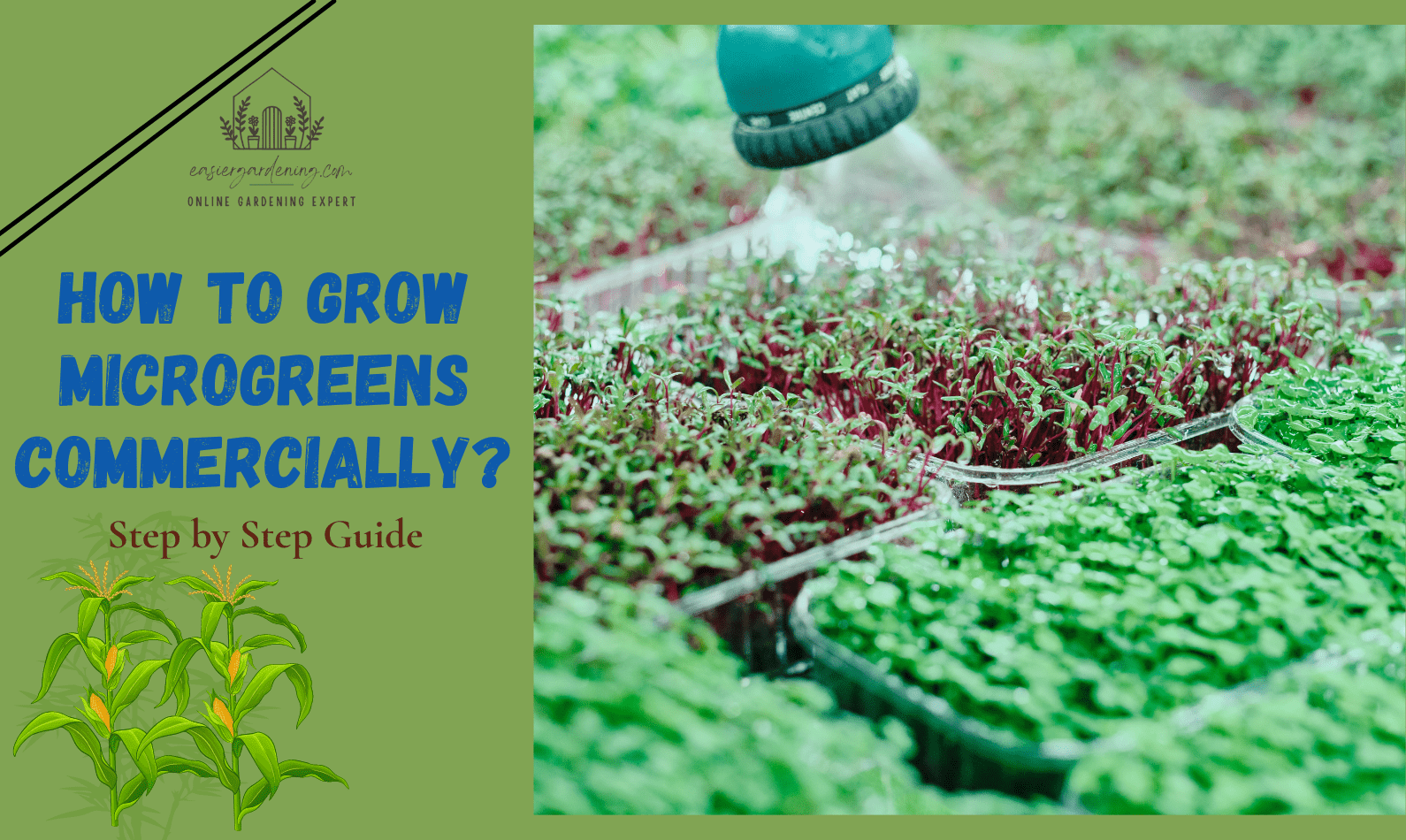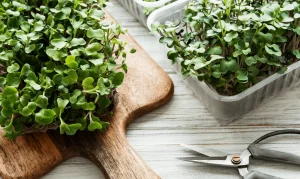How to Grow Microgreens Commercially?: We are all aware that microgreens are tasty and nutritious. However, did you know that growing them in your backyard can also be profitable?
Microgreen backyard farms have recently become famous. Small-scale microgreen farming can provide a living for many backyard growers. The good news is that you can build your microgreen farm as well!
You’ve come to the right place if you want to learn how to grow microgreens commercially. Today, I’ll go through everything you need to know before starting your own microgreen company!
Contents
- Advantages of Starting a Microgreens Business
- Microgreens Are High-Value Crops with a Massive Customer Base
- Easy to Get Started and Scale-Up
- Do Microgreens Grow Quickly?
- No Wasted Seasons
- How to Grow Microgreens Commercially? A Step-by-Step Guide
- Step 1: Prepare Your Supplies
- Step 2: Find Buyers
- Step 3: Water the Plants
- Step 4: Adjust the Temperature
- Step 5: Harvest the Microgreens
- What Are The Best Microgreen Plants to Grow?
- How Much Money Can A Microgreen Business Make?
- How Much Does It Cost To Start A Microgreen Business?
- Conclusion: How to Grow Microgreens Commercially?
Advantages of Starting a Microgreens Business
Before you get into the meat of the matter, you can do as all good business owners do. Assessing the advantages of your company is a critical step in making the most of it.
In the list below, I’ll go over all of the reasons why microgreen growing is a good idea for you.
Microgreens Are High-Value Crops with a Massive Customer Base
- One of the best things about microgreens is that they are usually expensive. Many customers would gladly pay top dollar for a batch of your freshly produced microgreens.
- Many microgreens are highly nutritious. They are high in vitamins, minerals, and other beneficial nutrients. Not only that, but they also enhance the flavor of foods.
- Aside from being nutritious and tasty, they also look fantastic on a plate. As a result, many restaurants use them as a garnish.
- Microgreens cater to a wide range of consumers for a variety of reasons. In other words, if you produce high-quality microgreens, you will always have a buyer waiting for you.
Easy to Get Started and Scale-Up
- Another significant advantage of microgreen farming is the low initial investment. For example, you can start with a couple of trays and produce enough microgreens to make a consistent profit.
- Aside from the trays, you’ll need seeds and a rising medium. But we’ll get to that later. For the time being, you need to know that you can make a profit with as little as two or three trays.
- Based on the preceding issue, starting a homegrown microgreens company is relatively simple. It will be simple to scale up once you start making steady profits.
- Scaling up is as easy as getting started. There is no new action because you can add more trays and prepare them as you did the first ones.
Do Microgreens Grow Quickly?
- Room isn’t the only thing you’ll need if you’re growing daily crops. Growing crops such as wheat or maize requires patience because harvesting the crops can take a full season.
- Microgreens, on the other hand, grow quickly. Instead, most microgreens grow rapidly and can be harvested less than a month.
- This rapid turnover translates into increased sales. It is beneficial when beginning a new company.
No Wasted Seasons
- Microgreens can be grown all year. To achieve similar results with regular crops, various special preparations, lighting, and a greenhouse are needed.
How to Grow Microgreens Commercially? A Step-by-Step Guide
As you already know, growing microgreens commercially is all about attracting the right buyers and scaling your farm up. You must, however, begin somewhere.
While growing microgreens is a relatively simple operation, you must make some critical decisions to benefit from it. Here are all the steps you need to take to start a small microgreen company.
Step 1: Prepare Your Supplies
Here’s a quick rundown of what you’ll need to get started with your microgreen company.
Trays
Each tray is usually 10 x 20 inches in size. The cost of trays varies. However, the majority of them are less than $5.
Most microgreen trays have holes in them to enable water to drain. These are ideal for growing in soil. There are, however, some trays with no holes that are ideal for hydroponic growing.
Seeds
Several plants qualify as microgreens.
- It would help if you chose a good seed variety from a reputable seller, whatever seeds you choose.
- Soaking the seeds in water overnight before seeding can help to speed up the germination process in some cases. However, you should not try this unless the kit states explicitly that you should.
- If you can’t find any directions for pre-soaking, it’s best to proceed with caution.
Water
Of course, you can water your seeds with any water. On the other hand, some microgreen types are fragile and need less chlorinated water.
In that case, you can depend on a more filtered water source. Even better, you can save money in the long run by investing in a water filter. To water your microgreens, you’ll also need a high-quality plant sprayer.
Growing Medium
- One of the most appealing aspects of microgreens is that they can be grown in almost any type of growing medium. Microgreens can be grown in soil, coconut coir, hemp mats, burlap, and other materials.
- However, to make a good profit from your farm, you must maximize yield. Growing microgreens in soil yielded the highest yield, according to studies.
- Furthermore, since the same microgreen soil can be reused, it is a more sustainable method in the long run. In your market, you should look for sustainability.
- Fox Farm Happy Frog Organic Potting Soil Mix is the best choice on the market. The best-selling soil contains all of the nutrients required for excellent microgreens development. It also has a low pH, which is suitable for the growth of microgreens.
Grow Lights
You won’t need any additional lighting systems if you cultivate your microgreens in a space with plenty of natural sunlight.
The type of microgreen being grown primarily determines the amount of light required by the plant. It is where having a lot of knowledge comes in handy.
Growing microgreens differs from growing normal crops in that you are not waiting for fruits to ripen. Instead, you progress to the first collection of leaves. Indoor lights come in a variety of styles, including:
- Strip lights
- Gooseneck LED lights
- Hanging LED lights
You can choose any of these lights based on your personal preferences and the size of your room. Adjust the lights to a safe distance away from the leaves to not burn or overheat.
Step 2: Find Buyers
Like I previously said, finding a consumer willing to purchase your goods will not be difficult. The best clients are:
- Restaurants
- Grocery stores
- Farmer’s market
If you don’t want to deal with the hassle of finding clients, you should go with a wholesale merchant. While you will make the least profit, you will save time and effort in seeking customers.
Step 3: Water the Plants
You can water your plants at least twice a day as a general rule. You can go 1 to 2 times a day once the seeds germinate. The aim is to keep the soil moist at all times.
However, do not soak the soil in water. It has the potential to suffocate the plant. Furthermore, it can cause the plant to rot.
Step 4: Adjust the Temperature
Fortunately, microgreens can withstand a wide range of temperatures. In general, you want to maintain the temperature between 65-degrees and 75-degrees Fahrenheit.
Step 5: Harvest the Microgreens
As you might know, microgreens usually are ready to harvest one week after planting and can last up to 28 days.
Microgreens should be harvested when they are about 1 to 3 inches tall. Simply cut them above the soil level with clean kitchen scissors. After collecting your microgreens, rinse and dry them on a paper towel before sealing them in an airtight bag with a sticker. It’s time to sell your products to the buyers now that you’ve packed your branded pack!
Frequently Answered Questions
What Are The Best Microgreen Plants to Grow?
Since microgreens are often used to add “zing” to the main course or salad, spicy varieties are the most common. Arugula, which adds a spicy, peppery flavor to other foods,includes basil, celery, cabbage, cilantro, a common spicy herb, endive, mustard, and tangy radish them. Growers will also produce a variety of colorful greens, such as rainbow chard or kale, in addition to the traditional spicy microgreens.
Learn more about Most Popular Microgreens for Chefs
How Much Money Can A Microgreen Business Make?
Commercial farmers may make a good living in a small area because the crop cycle is short. Most microgreen varieties mature in about two weeks, allowing a skilled grower to produce 20-25 crops per year. By stacking the growing channels or trays vertically, you can generate four times as much in the same amount of space.
Many growers use a four-rack system to produce an average of 50 pounds of microgreens in a 60 square foot growing area per two-week crop cycle. At $25 per pound, that’s a better return than almost every other legal crop. When grown on a single stage, such as a tabletop, most growers record an average harvest of 5 to 6 ounces of microgreens per single tray (10′′ x 20′′).
How Much Does It Cost To Start A Microgreen Business?
Since growing microgreens do not necessitate the use of costly machineries such as tractors and tillers, the startup costs can be very low, as low as a few hundred dollars. Indoor growers can save money by using low-cost fluorescent fixtures, and outdoor growers can create a simple hoop house to grow microgreens for about $3 per square foot.
Conclusion: How to Grow Microgreens Commercially?
With that said, you now have a comprehensive understanding of growing microgreens commercially. As you can see, the microgreen business is relatively easy, and you will be making real profits in less than a month.
Learn more about Most Popular Microgreens for Chefs. Even if you already have a standard farm, including a microgreens segment can be highly advantageous to off-season financing. You can start your farm successfully if you follow this guide. Remember that awareness is the secret to success in the microgreen industry. That is why you should always be on the lookout for new farming techniques and technologies.




